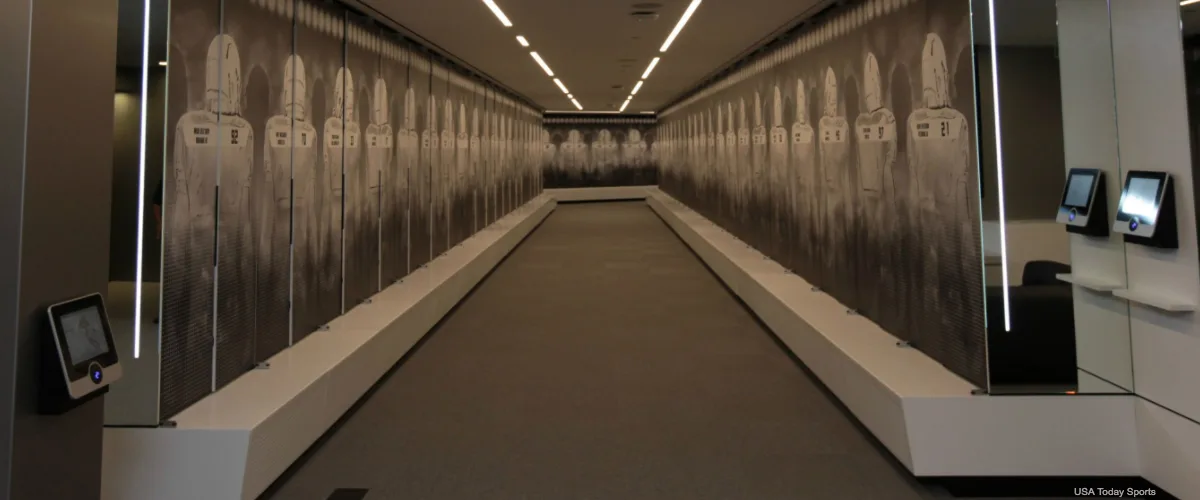Topics
- Article
The Smart Locker Room?

Elite athletes spend an extraordinary amount of time in the locker room. For pros, it’s basically the equivalent of their office, as well as their home away from home. This is what inspired WHOOP founder and CEO Will Ahmed to name our blog “The Locker.” In his words:
“For athletes reading this, you know that locker rooms are both sacred and messy places. They’re private and intimate, yet boisterous and warm. There’s a pact for those on the inside; a curiosity for those left out. They can be emotional places: Inspirational speeches surround victorious athletes; a lonely silence can follow those who come up short. Clothes and equipment are tossed about but also seemingly shared from one athlete to another, an unspoken understanding of ownership signified by numbers, scratches, and stains that to an outsider seem indiscernible. There’s an order to this chaos.”
In my days as a high school tennis player and later a coach, I was impressed with any locker room that had doors on the stalls and a floor I wasn’t afraid to walk around on barefoot. But as technology takes on its ever-growing role in the evolution of sports, locker rooms are becoming increasingly more advanced.
The image above is from the University of Oregon football locker room, part of a $68-million complex that opened in 2013. It’s amenities include a two-story weight room, a health center with a hydrotherapy pool, a cafeteria, a barber shop, a 170-seat theater and flat screen TVs everywhere.
Clemson University is scheduled to unveil a new facility in January that, in addition to all of those things, will also feature an indoor golf simulator, an arcade, a bowling alley, laser tag and a recovery/nap room.

Via The State, Clemson’s director of recruiting and external affairs Thad Turnipseed said the following about the nap room, which will include bunk beds, bean bags and massage chairs:
“The number one problem is lack of sleep, and right now what guys do all over the country is bring a pillow and go find a staircase or locker or hallway, and they’ll lay down and sleep, especially during two-a-days and really all year long. The nap room cost very little and is a great benefit.”
In October of 2012, Judy Bautista of the New York Times wrote about the then brand new locker room constructed by the NFL’s Jacksonville Jaguars:
“[It] looks like a cross between a high-end nightclub (a 41,600-watt sound system) and a five-star hotel (stacked stone wall tile) and is so deluxe that the team recently used it to host a dinner for sponsors. That would have been an unappetizing proposition in the days of cinder-block rooms decorated with overflowing laundry baskets and crumpled tape. … The Jaguars have embraced their inner interior designer, replete with two waterfalls that splash into plunge pools, Euro-style toilets inside individual private stalls and leather chairs custom-built extra wide to accommodate even the heftiest linemen. There are ventilation systems built into each locker to dry equipment, helping the Jaguars to pull off the unimaginable: the locker room smells like a new car instead of a sweaty sock.”
As impressive as these state-of-the-art locker rooms are, what can we expect to see in the years ahead? From a recent post on IBM.com’s Think Leaders blog:
“What if a locker room could listen to the coaches and players? What if it could automatically cue up video clips of key plays in the first half, based on what the players and coaches are discussing at halftime? What if it analyzed statistics, recommended substitutions, and suggested alternative plays?
Sounds ridiculous, right? Well, let’s think about it for a minute. A few weeks ago, at the World of Watson show in Las Vegas, IBM announced a partnership with Harman, the maker of audio, video, lighting and control systems. Harman is going to start using IBM Watson to help manage hospital, hotel, and conference rooms. Using voice-activated assistance, Watson will help patients or guests to control various aspects of the room – from the lights to the thermostat to the audio/visual equipment.”
A locker room that can advise athletes on when to rest and how hard to push their training may well be the future of college and professional sports.